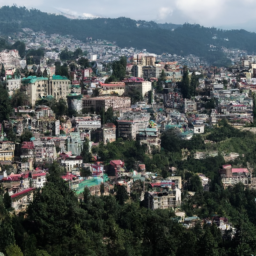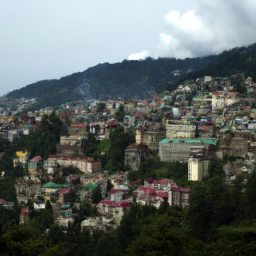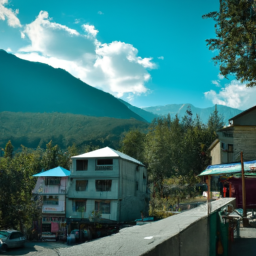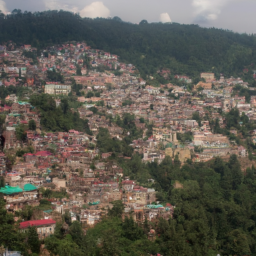 Nestled in the lap of the Himalayas, Himachal Pradesh is a treasure trove of natural beauty, adventure, and tranquility. The state is renowned for its picturesque hill stations, each offering a unique blend of scenic landscapes, cultural richness, and recreational activities. From the bustling markets of Shimla to the serene meadows of Kufri, these hill stations are perfect getaways for those seeking respite from the chaos of city life.
Nestled in the lap of the Himalayas, Himachal Pradesh is a treasure trove of natural beauty, adventure, and tranquility. The state is renowned for its picturesque hill stations, each offering a unique blend of scenic landscapes, cultural richness, and recreational activities. From the bustling markets of Shimla to the serene meadows of Kufri, these hill stations are perfect getaways for those seeking respite from the chaos of city life.
One of the most popular hill stations in Himachal Pradesh is Kufri, located just a short drive from Shimla. Known for its breathtaking views and pleasant climate, Kufri is a haven for nature lovers and adventure enthusiasts alike. The region is famous for its skiing opportunities in winter and lush green landscapes during the summer months. Visitors can indulge in various activities such as horse riding, trekking, and even enjoying a thrilling ride on a toboggan. The charm of Kufri lies in its ability to cater to both adventure seekers and those looking for a peaceful retreat.
For those planning a trip to this enchanting region, websiteservice4all offers a plethora of travel resources and tips to make your journey memorable. Whether you are looking for accommodation options or local attractions, their comprehensive guides can help you navigate through the best experiences Himachal Pradesh has to offer.
Another gem in the crown of Himachal Pradesh is Manali, a hill station that attracts tourists from all over the world. With its stunning landscapes, vibrant culture, and numerous adventure sports, Manali is a must-visit destination. The Solang Valley, located nearby, is famous for its skiing and paragliding activities, making it a hotspot for thrill-seekers. Additionally, the picturesque Old Manali village offers a glimpse into the local culture, with quaint cafes and shops lining the streets.
As you explore the various hill stations, don’t forget to take a moment to appreciate the local cuisine. Himachali food is a delightful experience, with dishes like Chana Madra and Siddu that reflect the region’s rich culinary heritage. For more info, visit termite-pestcontrol-longbeach.com to discover local dining options that will tantalize your taste buds.
Kufri is not just about adventure; it also boasts several attractions that are worth visiting. The Himalayan Nature Park is a great place to learn about the region’s flora and fauna, while the Mahasu Peak offers panoramic views of the surrounding mountains. Families can enjoy a day out at the Fun World amusement park, which features various rides and activities for children. The blend of nature and entertainment makes Kufri an ideal destination for families and solo travelers alike.
When planning your visit, consider reaching out to websiteservice4all for assistance in organizing your itinerary. Their expertise in travel planning can help you make the most of your time in Himachal Pradesh, ensuring you don’t miss out on any hidden gems or must-see attractions.
Another hill station that deserves a mention is Dharamshala, known for its Tibetan culture and serene environment. Home to the Dalai Lama, this town offers a unique spiritual experience alongside its natural beauty. Visitors can explore the Tsuglagkhang Complex, which houses the Tibetan Museum and various monasteries. The surrounding mountains provide ample opportunities for trekking and meditation, making it a perfect spot for those seeking peace and reflection.
As you traverse through these enchanting hill stations, you will find that each destination has its own unique charm. Whether it’s the vibrant markets of Shimla or the tranquil landscapes of Kufri, there is something for everyone in Himachal Pradesh. To enhance your travel experience, consider checking out websiteservice4all for tips on local customs and traditions that will enrich your journey.
For adventure enthusiasts, the region offers numerous trekking trails that cater to all skill levels. The trek to Triund, for instance, is a popular choice among trekkers, providing stunning views of the Dhauladhar range. The journey is not just about reaching the destination; it’s about experiencing the beauty of nature along the way. As you hike through lush forests and meadows, you’ll encounter diverse wildlife and breathtaking vistas that will leave you in awe.
In addition to trekking, Himachal Pradesh is also known for its vibrant festivals. The state celebrates various cultural events throughout the year, showcasing its rich heritage and traditions. The Kullu Dussehra, for example, is a grand festival that attracts thousands of visitors, featuring colorful processions, traditional music, and dance performances. Participating in these festivals can provide a deeper understanding of the local culture and create lasting memories.
As you plan your trip, remember to take advantage of the resources available through websiteservice4all. Their insights can help you navigate the best times to visit, local events, and must-see attractions, ensuring a well-rounded experience in Himachal Pradesh.
the hill stations of Himachal Pradesh offer a perfect blend of adventure, culture, and natural beauty. From the bustling streets of Shimla to the serene landscapes of Kufri, each destination has its own unique allure. Whether you are seeking adventure or tranquility, Himachal Pradesh has something to offer everyone. So pack your bags and get ready to explore the enchanting hill stations that await you in this beautiful region of India.
 Nestled in the lap of the majestic Himalayas, Himachal Pradesh is a treasure trove of natural beauty, adventure, and cultural richness. This northern Indian state is renowned for its stunning landscapes, charming hill stations, and vibrant local traditions. From snow-capped peaks to lush green valleys, Himachal Pradesh offers a diverse range of experiences for every type of traveler. In this article, we will explore some of the top tourist destinations in this picturesque region, showcasing the scenic beauty that makes it a must-visit.
Nestled in the lap of the majestic Himalayas, Himachal Pradesh is a treasure trove of natural beauty, adventure, and cultural richness. This northern Indian state is renowned for its stunning landscapes, charming hill stations, and vibrant local traditions. From snow-capped peaks to lush green valleys, Himachal Pradesh offers a diverse range of experiences for every type of traveler. In this article, we will explore some of the top tourist destinations in this picturesque region, showcasing the scenic beauty that makes it a must-visit. Himachal Pradesh, nestled in the lap of the Himalayas, is a treasure trove of cultural heritage, traditions, and customs that reflect the rich tapestry of its history and the diversity of its people. This northern Indian state is not just known for its breathtaking landscapes and adventure tourism but also for its vibrant cultural practices that have been passed down through generations. From folk music and dance to festivals and handicrafts, the cultural heritage of Himachal Pradesh is a fascinating blend of various influences, making it a unique destination for travelers and culture enthusiasts alike.
Himachal Pradesh, nestled in the lap of the Himalayas, is a treasure trove of cultural heritage, traditions, and customs that reflect the rich tapestry of its history and the diversity of its people. This northern Indian state is not just known for its breathtaking landscapes and adventure tourism but also for its vibrant cultural practices that have been passed down through generations. From folk music and dance to festivals and handicrafts, the cultural heritage of Himachal Pradesh is a fascinating blend of various influences, making it a unique destination for travelers and culture enthusiasts alike. Himachal Pradesh, a picturesque state nestled in the lap of the Himalayas, is renowned for its breathtaking landscapes, rich biodiversity, and vibrant cultural heritage. Among its many treasures, the temples and festivals of Himachal Pradesh stand out as significant markers of the region’s history and traditions. These sacred sites and celebratory events not only reflect the spiritual essence of the people but also serve as a window into the diverse cultural tapestry that defines this enchanting state.
Himachal Pradesh, a picturesque state nestled in the lap of the Himalayas, is renowned for its breathtaking landscapes, rich biodiversity, and vibrant cultural heritage. Among its many treasures, the temples and festivals of Himachal Pradesh stand out as significant markers of the region’s history and traditions. These sacred sites and celebratory events not only reflect the spiritual essence of the people but also serve as a window into the diverse cultural tapestry that defines this enchanting state. Nestled in the lap of the Himalayas, Himachal Pradesh is a treasure trove of natural beauty, adventure, and tranquility. The state is renowned for its picturesque hill stations, each offering a unique blend of scenic landscapes, cultural richness, and recreational activities. From the bustling markets of
Nestled in the lap of the Himalayas, Himachal Pradesh is a treasure trove of natural beauty, adventure, and tranquility. The state is renowned for its picturesque hill stations, each offering a unique blend of scenic landscapes, cultural richness, and recreational activities. From the bustling markets of 



